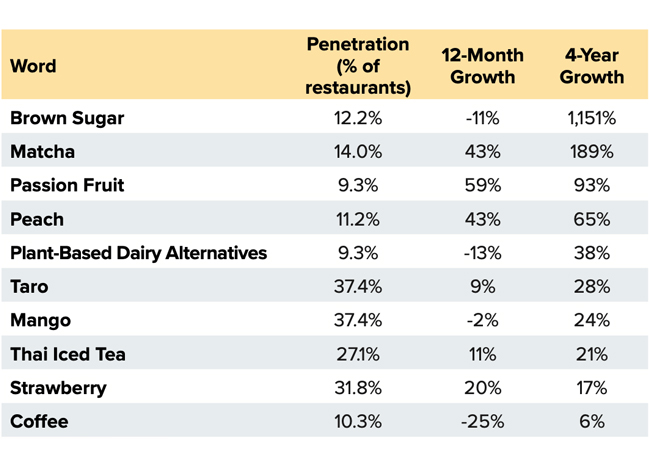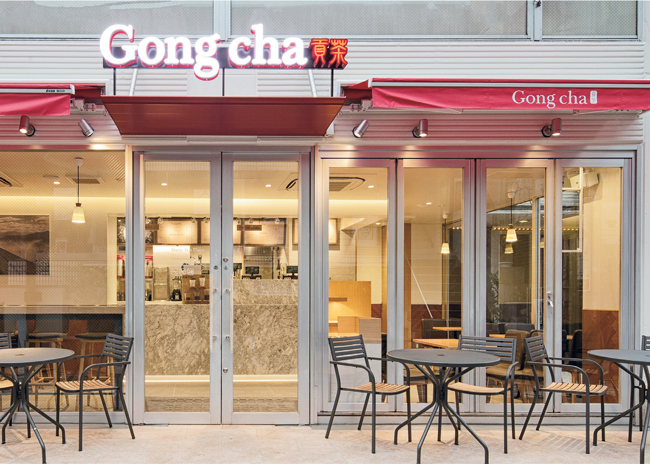Due to both operators’ increased ability to customize this beverage’s sweetness and the availability of nondairy milk alternatives, market research firms project plenty of growth for the bubble tea segment in the coming years.
By the Numbers
 Also known as boba or black pearl tea, bubble tea is a sweet concoction that combines tea, milk or a nondairy creamer, ice and black tapioca pearls.
Also known as boba or black pearl tea, bubble tea is a sweet concoction that combines tea, milk or a nondairy creamer, ice and black tapioca pearls.
Bubble tea is a $1.4 billion industry with revenue anticipated to rise at an annualized rate of 2.2% to $1.5 billion between 2021 to 2026, reports IBISWorld. Following suit, the number of industry operators is expected to increase at an annualized rate of 15.2% for a total of 5,317 operators during the same five-year period. A large number of sole proprietors will drive this growth, per IBIS projections.
Menu mentions of bubble tea have increased 8.4% over the past year, reports Chicago-based Technomic. Mentions of plant-based milk on bubble tea menus have grown 23.3% over the past year, making it the fastest-growing ingredient in this menu segment.
New Developments
Besides conventional bubble teas, chains have increasingly offered a wider variety of fusion bubble teas, reports IBISWorld. These variations incorporate fruits, matcha, brown sugar, cheese foam and other new flavors. IBISWorld notes that some industry operators now aim to transform this beverage to be more artisan and customized, which will expand this category’s demographic in the years ahead.
Penetration
The percentage of bubble tea menus that include a mention of this ingredient

Concept Close-Up: Gong cha
 Image courtesy of Gong chaWith 1,900 locations in 22 countries and 190-plus stores in 19 U.S. states, Gong cha has established itself as a dominant bubble tea chain and brand. It started in Taiwan more than two decades ago.
Image courtesy of Gong chaWith 1,900 locations in 22 countries and 190-plus stores in 19 U.S. states, Gong cha has established itself as a dominant bubble tea chain and brand. It started in Taiwan more than two decades ago.
“We are known for our proprietary teas and being the first brand to introduce a milk foam topping to the beverage,” says Gong cha president of the Americas Geoff Henry. “This not only adds an extra layer but also a cool visual that has become a popular addition to Instagram and other social media.”
Gong cha’s menu consists of five varieties: milk foam, milk tea, slush, creative and coffee. It also offers tea lattes and provides a choice of black, green, oolong or Earl Grey bubble tea. Customers can adjust the sweetness and choose from toppings, such as aloe, pudding, Oreo crumbs, basil seeds and herbal jelly.
According to Henry, bubble tea’s popularity has grown due to it being easy to customize as well as it providing an energy boost through caffeine but also having health benefits. This beverage’s eye-catching presentation deems it photo worthy, making bubble tea a hot commodity on social media.
Gong cha’s back of the house is simple, and the equipment lineup depends on the location. “We use induction heating to prepare our teas, although some locations have traditional ranges,” Henry says.
Its sites have three- or four-bay sinks, ice-making equipment, undercounter reach-in coolers and a number of tea urns. “We prepare tea every three and a half to four hours,” Henry says. “We also have a lot of smallwares as well as anywhere from one to three blenders for preparing our iced beverages.”
Operators seal cups of bubble tea at the top; Gong cha utilizes proprietary sealers from Taiwan to top cups with a thin, plastic film.
The boba prep is a 45-minute process. The pearls arrive in an ambient state and are boiled by staff. Staff remove the water and add brown sugar for a 20-minute soak. Once prepared, the boba has a three-hour shelf life. “When customers walk in, all our tea urns are on display behind the counter so they can see the types of tea we offer,” Henry says. “Ours is a fairly simple store design and layout relative to other foodservice concepts.”
He adds that part of bubble tea’s appeal is the double enjoyment factor — consumers can drink the beverage and then suck up and chew the boba. “So many of our customers are high school and college students who see this as a stress reliever,” Henry says. “Chewing boba provides a soothing sensation, so there are psychological benefits to this category.”
Although boba, which is made from tapioca starch, began as an ice cream topping in Asia, it is now the cornerstone of the bubble tea category. “Now, there is so much innovation with this ingredient,” Henry notes.



